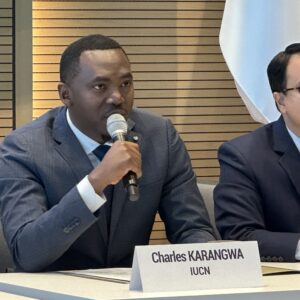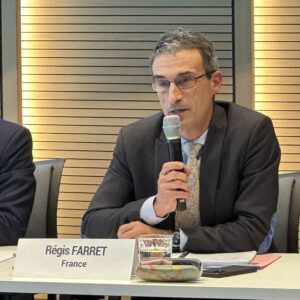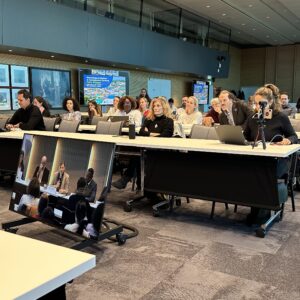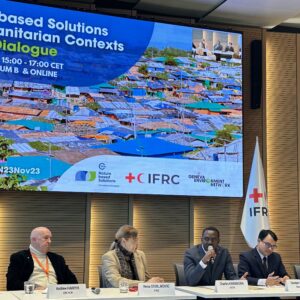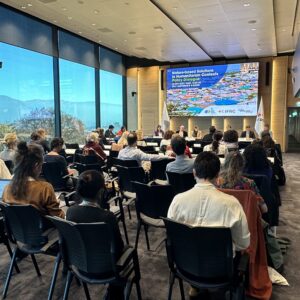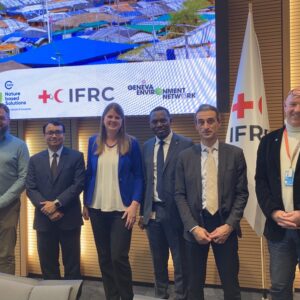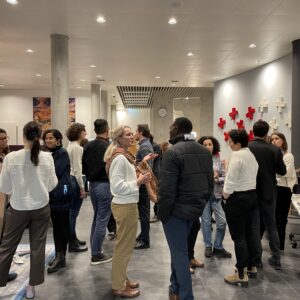Event Conference
Nature-based Solutions in Humanitarian Contexts | Policy Dialogue

23 Nov 2023
15:00–17:00
Venue: IFRC | Auditorium B & Online | Webex
Organization: International Union for Conservation of Nature, International Federation of Red Cross and Red Crescent Societies, Geneva Environment Network
Co-organised by the International Federation of Red Cross and Red Crescent Societies, the International Union for Conservation of Nature and the Geneva Environment Network, this event offered an opportunity to amplify common messaging on the interlinked nature-climate-humanitarian crises and the need of common narrative for tackling both climate emergency and humanitarian action.

About this Event
Implementing Nature-based Solutions could reduce the number of people in need of international humanitarian assistance due to climate change and weather-related disasters… By 2030, 150 million people a year could need humanitarian assistance due to floods, droughts, and storms. By 2050, this is expected to rise to 200 million people annually.
Working with Nature to Protect People: How NbS Reduce Climate Change and Weather-Related Disasters, IFRC and WWF, 2022
In the coming decades growing disaster risk, driven in part by climate change and environmental degradation, threatens to exceed the humanitarian sector’s capacity to respond to crises. The increasing severity and frequency of climate-related disasters exacerbate underlying risks, stoke conflict, and undermine humanitarian and development gains.
Within these complex humanitarian response dynamics, the environment is often overlooked, not prioritized, or is treated as an afterthought. Yet the environment is fundamental to effective humanitarian action for two primary reasons:
- a degraded environment can trigger or worsen a humanitarian crisis; and,
- humanitarian operations can damage the environment, exacerbating underlying vulnerability and risk.
Nature-based Solutions (NbS) are a powerful tool for enhancing resilience, supporting sustainable development, and improving the quality of life of affected communities while safeguarding the livelihoods and ecosystems they depend upon. Nature-based Solutions can provide multiple benefits simultaneously relevant to humanitarian contexts and are one key approach not only for adapting to climate change but also for preventing loss and damage and sustainably managing natural resources.
Guidance on how to integrate NbS in humanitarian contexts can be found in the Sphere Unpacked Guide on Nature-based Solutions for Climate Resilience in Humanitarian Contexts.
The 28th United Nations Framework Convention on Climate Change (UNFCCC) Conference of the Parties (COP) in December, will hold for the first time ever a thematic day on “Relief, Recovery and Peace” (3 December) thus recognising the interlinkages between nature-climate-humanitarian crises. A key day to foster discussions on accelerating adaptation actions, preventing and addressing loss and damage, in both fragile and conflict-affected contexts.
Co-organised by the International Federation of Red Cross and Red Crescent Societies (IFRC), the International Union for Conservation of Nature (IUCN) and the Geneva Environment Network, this event offered an opportunity to amplify common messaging on the interlinked nature-climate-humanitarian crises and the need of common narrative for tackling both climate emergency and humanitarian action.
As UN Secretary-General António Guterres pointed out in September 2020, “the climate emergency is a race we are losing, but it is a race we can win.”
Speakers
By order of intervention.

Nena STOILJKOVIC
Under Secretary General for Global Relations, Humanitarian Diplomacy and Digitalization, IFRC

Charles KARANGWA
Global Head, Nature-based Solutions, IUCN

Goutam Kumar DEY
Counselor, Permanent Mission of the People's Republic of Bangladesh to the United Nations Office and other international organizations in Geneva

Régis FARRET
Counselor Sustainable Development, Permanent Mission of France to the United Nations Office and other international organizations in Geneva

Andrew HARPER
Special Advisor on Climate Action to the High Commissioner for Refugees, UN High Commissioner for Refugees

Manuel MARQUES PEREIRA
Head of Division, Migration, Environment, Climate Change and Disaster Risk Reduction, IOM

Ninni IKKALA NYMAN
Lead for Climate and Resilience (a.i), IFRC | Moderator
Summary
Nena STOILJKOVIC | Under Secretary General for Global Relations, Humanitarian Diplomacy and Digitalization, IFRC
- IFRC is the largest volunteer-based humanitarian network in the world, present in every single country in the world through its national society or Red Cross-National Societies.
- IFRC work focuses on disaster response, with numerous disasters climate-induced, where we help millions of people each year; and on longer-term resilience-building programs where we reach 160 million people each year.
- We have been collaborating with the International Union for Conservation of Nature (IUCN) through the NbS in Humanitarian Contexts Working Group since 2021. Such collaboration was further strengthened by the signing of a Memorandum of Understanding (MOU) with IUCN in order to turn it into something.
- Climate disasters are becoming more frequent and more intense. 2023 will be remembered as one of the hottest years in history.
- Never before has climate change been so acutely felt by so many around the world. Biodiversity loss and ecosystem collapse are one of the fastest deteriorating global risks over the next decade with far-reaching and devastating economic and social consequences.
- The Intergovernmental Panel on Climate Change (IPCC) reports indicate that the environmental and climate crises are also humanitarian crises and that is why we, as a humanitarian organization, have stepped up to speak and do something about it. We see working with nature and nature-based solutions as part of an integrated approach to climate change adaptation and disaster risk reduction. We also recognize that NbS benefits are cross-cutting through the humanitarian response including on food security and nutrition, water security and water, sanitation and hygiene (WASH) and health.
- Last year at the UN Climate Change COP27, IFRC launched its Global Climate Resilience Platform, an ambitious plan to reach 500 million people over the next five years through the work of our national societies. It aims to raise 1 billion Swiss Francs to take our climate action at the community level to scale.
- One of the three pillars of this platform is NbS. We aim to ensure that national societies – the most impacted by climate – in the next five years harness the power of nature through NbS focused on reducing disaster risks, adapting and mitigating climate change.
- All organizations must step up their efforts to address both climate and environmental crises.
- This session will be focusing on how best to address the interlinked nature-climate-humanitarian crisis and the need for a common narrative, especially as we are going into COP28 to tackle both climate emergency and humanitarian action .
- While nature-based Solutions have been on the COP screen for a while including through COP nature days and related declarations, this year we have a huge opportunity because we will host a Relief, Recovery, and Peace Day including a declaration on this issue; indeed, there could not have been a better moment for us to gather together and to come up with a joint partnership on making an impact in these areas.
Charles KARANGWA | Global Head, Nature-based Solutions, IUCN
- Significant progress on the links between the environment and the humanitarian crises was made since the United Nations Conference on Human Environment in 1972 and the Rio Summit in 1992.
- Climate change is the top driver of humanitarian emergencies, we see daily through food, water, flood and drought crises.
- Environmental degradation drives a burden on the humanitarian crisis across the world, which is further aggravated during times of war.
- In Kenya, where more than 30% of the population and 70% of the national livestock are under constant threat because of droughts, last year alone more than three million heads of livestock were completely lost because of droughts. This is exactly how the environment connects to the humanitarian crisis. We cannot underestimate the economic cost of this connection when it comes to our national GDPs and the overall development pathways.
- As the impact of climate change becomes more visible and connected to other crises we are facing like biodiversity loss and pollution, we need to start looking at how to address this together.
- Historically, development and environment have been not necessarily connected sectors. Conservation has often been looked at as a scientific topic but most importantly, nature was significantly considered when addressing the interlinkage between thes crisise.
- The time to talk about NbS within a humanitarian context and to address the climate, biodiversity and pollution crises together is now.
- As part of this broader solution, we are talking about reinforcing coordination and collaboration between environmental scholars, development practitioners but also humanitarian response. This should also happen within the policy framework.
- We have been discussing with different countries that are developing national NbS plans. One of the key threats being considered is natural disasters from flooding and droughts, which are worsening and increasing the humanitarian demands.
- IFRC and IUCN together with other partners such as the United Nations High Commissioner for Refugees (UNHCR) are looking at how to raise this to the highest level and taking steps towards action to address these problems.
- One of the works that IUCN has been doing over the last years is to put out important tools and knowledge products that can help the community of practitioners to be able to uptake these solutions. This includes the Global Standard on nature-based solutions, which helps define the NbS and helps people understand what qualifies it and what does not qualify.
- Addressing these things in silos must be substituted with an integrated approach to humanitarian crises, which is strictly connected to the environmental crises.
- Cooperation needs to be accelerated at different levels, including the policy and financing level to seek out better ways to address such crises.
Ninni IKKALA NYMAN |Lead for Climate and Resilience (a.i), IFRC | Moderator
- Around six months ago, IFRC hosted a joint workshop on the new Sphere Nature-based Solutions guide, a specific guide on how humanitarians apply humanitarian principles in operations.
- This resulted in the formulation of key messages:

- We need to be looking at the ‘do no harm’ principle from an environmental perspective. Humanitarian operations must not worsen the environmental situation. We begin to shift towards the idea that in a context of protracted crises, NbS can help sustainably manage, conserve or restore ecosystems that can become relevant for populations who are in either a permanent or temporary situation. This speaks to what’s the role of Nature-based Solutions in protecting lives and providing for livelihoods.
- Unleashing the power of NbS in reducing disaster risk requires also longer-term approaches for dealing with those disasters.
- NbS need to be locally led. They need to support equity and effectiveness.
- Cross-sectoral partnerships are important because humanitarians are not going to become environmental experts and the other way around, therefore collaboration must be addressed.
- The lack of financing is a real problem in prohibiting the ability to act requiring advocacy for further financing and non-siloed financing across climate, environmental and humanitarian areas.
Goutam Kumar DEY | Counselor, Permanent Mission of the People’s Republic of Bangladesh to the United Nations Office and other international organizations in Geneva
- As one of the most climate-vulnerable countries in the world, Bangladesh is at the tipping point of the crisis. We have a carbon footprint of less than 0.6 tons per capita against the global average of 6.5 tons. However, extreme temperatures, erratic rainfalls, drought, even more intense tropical cyclones, sea level rise, increasing salinity seasonal variations, and riverbank erosion are causing severe negative impact effects on the lives and livelihoods of millions of people in the country.
- It comes as no wonder that NbS have been practiced in Bangladesh for many years. We started the coastal forestation activities in Bangladesh back in 1965. Since then Bangladesh Forest Department has continued the practice and establish plantations in 210,000 hectares of coastal areas. These plantations prevent coastal erosion, trap sediment by slowing down the current reducing the causality and damage made by natural disasters.
- Fifty percent of our land is wetland, in wetland ecosystems NbS are practiced largely in the northern part of Bangladesh through wetland habitat restoration reintroduction of locally rare or loss species and watershed management to increase water availability, support food production and fisheries enhanced wetland biodiversity.
- Decades ago, our government initiated the protected area co-management scheme for different forest areas to involve the local community in the implementation and management of NbS. We promote traditional practices to protect the human-environment relationship, for example with floating gardening: a traditional agricultural practice using plant materials to make floating rafts in water-locked areas, enabling people to raise seedlings and grow vegetables in monsoon periods.
- For policy-level interventions, Bangladesh has several medium-term and short-term plans along with long-term visions for development planning addressing climate change, protecting the environment and conserving biodiversity.
- Bangladesh has adopted the Bangladesh Delta Plan 2100, a long-term integrated and holistic approach towards environmental sustainability for Bangladesh.
- For more than six years, Bangladesh has been hosting over 1.2 million Rohingya who are displaced from Myanmar: along with other stakeholders and UN agencies Bangladesh government has been providing humanitarian assistance to these refugee people.
- The Cox Bazar area is at high risk for landslides and flashfloods, so the Bangladesh government with other UN agencies have been working to reduce uh the risks of disasters and we have done these things very successfully and we have reported that less casualties and damages have been done or caused by natural disasters in the Cox Bazar area.
- Since 2018 over 3,200 hectares of area have been reforested with the help of UNHCR and our forest department letting the environment to return to its original situation. Moreover, to congest the camps in Cox Bazar, the Bangladesh government has recently built new shelters on Ashar Char Island. We are providing better infrastructure on this island, and as of now, 33,000 Rohingya have been voluntarily relocated from Cox Bazar to this new island.
- Bangladesh is also trying its best at the international level, NGOs, IGOs, and other stakeholders to come forward to help Bangladesh so that we can manage these things efficiently.
Régis FARRET | Counselor Sustainable Development, Permanent Mission of France to the United Nations Office and other international organizations in Geneva
- The President of the French Republic visited Bangladesh in September and the adaptation and biodiversity challenges were at the heart of this discussion at that time.
- Climate change is increasing our risks of both extreme events such as storms or floods, but also more slow-onsetting ones such as droughts that can cause changes in biodiversity, or also meteorological changes that can alter the circulation of marine currents and therefore.
- Consequences of these events can be economic, agricultural, social and humanitarian because these can disrupt traditional know-how and lead to population displacements.
- The Platform on Disaster Displacement is a platform for pulling skills and providing support to countries our local communities to prevent forced migration or to better manage its consequences. France is honored to be one of the founding members of this platform and we are co-chairing the subgroup devoted to climate and migration with Bangladesh.
- Nature-based Solutions are not only a way of developing, managing and restoring ecosystems, but they are also a way of ensuring added value for society and human well-being and the economy. They are part of the solution, and it is a priority for France to uplift this co-benefit and added value for the economy.
- France has always seen it as a priority and a common tool that can be used to develop co-benefits between climate and biodiversity.
- We have to be cautious and to promote clear criteria. We support a concept for NbS that is faithful to the resolution of the UN Environment Assembly last year and it was defined with the help of IUCN, with particular attention to the respect of social and environmental guarantees and with a clear link to local communities, indigenous people and local knowhow to manage the projects and to ensure also their long-term resilience.
- French AFD (French Agency for Development) has set a target of 30% of France’s climate finance to be backed by biodiversity co-benefits, this includes NbS. This scheme could be replicated by other development agencies.
- Last year AFD supported 18 projects. One example is the Kiwa initiative developed in the Pacific Island States and territories, and it has been developed into a unique partnership driven by France and the European Union but also involving Canada Australia, and New Zealand.
- We should address, warn and alert about climate events through prevention. Last year the UN launched the Early Warnings for All Initiative while in 2015 France launched an initiative – Crews – devoted to early warning and climate risk. It is especially devoted to vulnerable States, and its goal is to build capacity across the entire chain of hydro-meteorological forecasting, dissemination of warnings to relevant stakeholders on the field, risk management and preparedness.
- Concrete actions are undertaken all over the world and Crews currently has 12 contributing States plus observers and it is one example of the actions that we should have to prevent on the field.
- France is very happy to play its part in such mechanisms, also here in Geneva in taking into account the convergence between environmental, social, and humanitarian issues.
- This is not an easy nexus to address, but to do so we must think global and act local.
Andrew HARPER | Special Advisor on Climate Action to the High Commissioner for Refugees, UN High Commissioner for Refugees
- The world is losing anywhere between 12 and 20 million hectares of land per year. Countries like Niger, for instance, are losing about 200,000 hectares.
- We are nowhere near coming up with any solutions. We are sort of touching around the edges without really being serious about it. Until we are serious about it, we will be responding in a humanitarian way because there will be more and more crises and we are going to fail because the number of people in need will go beyond displaced people and include host communities and everyone living in these marginal areas.
- The example of working with IUCN and Bangladesh is a good example because it addresses climate change, biodiversity, land, air, sea and pollution. It also raised a common challenge faced in humanitarian contexts: when a large number of displaced people use the host country’s resources in an unsustainable way, the welcome mat will not stay for very long.
- Humanitarians have to be environmentalists, just like they have to be development experts because the issues of climate change or nature will not be resolved with the current approach.
- We have to be linked with countries, development agencies, the populations and the private sector. Without these, solutions will not be sustainable.
- A challenge that we were confronted with in Cox’s Bazar is one of the reasons why the trees kept growing, was that we provided (Liquefied petroleum gas) LPG gas.
- We are a protection agency. Our mission is to protect people, not trees. We do a poor job at protecting trees: about 25 million trees are being cut down in refugee areas around the world, of which only about a million or two are then replaced.
- We belive that is necessary to plant many more millions trees to protect people. For instance, to cope with the impacts of the enormous amount of refugees going from Sudan into Chad, one of the most climate-environmentally sensitive areas in the world.
- The overall international refugee protection framework is reliant on us doing a better job in terms of nature-based solutions.
- We may not have necessarily been up to the standard in the past. Still, we have no choice but to be climate experts. We must collaborate with IUCN, development actors, and the World Bank, among others.
Manuel MARQUES PEREIRA | Head of Division, Migration, Environment, Climate Change and Disaster Risk Reduction, IOM
- Cox’s Bazar is the perfect example of the worst-case scenario turned into the best situation possible because willingness, money, restrictions, and space to negotiate happened.
- No disaster is natural: disasters are socio-economical phenomena and need to be treated as such, and it is the vulnerabilities of communities and individuals vis-à-vis hazards that should be managed and for which we should reduce exposure and we should create more resilience of people that need to be addressed.
- Working against nature is a problem. When we cut mangroves in areas prone to cyclones then we need to do reconstruction because the surge storm is stronger. When communities have livelihoods that are based on deforestation of slopes we have mudslides, we have floods.
- First the part of working with communities and governments in areas at risk to build adaptation that is resilient, so that the people that want to stay can stay in safety and with the resources to do so. There will be a group of people that will surely want to live because it should be their choice. The right to choose about mobility is something that IOM is pointing very strongly.
- The right to stay and its collisions with nature-based solutions is one of the biggest things that humanitarians have to come to terms with in regard to prevention. If we work on this before a disaster happens, we avoid humanitarian needs and have available humanitarian money for most pressing humanitarian needs. On the other side, when we are doing humanitarian we also need to do things differently.
- Cox’s Bazar had a significant number of restrictions by the government of Bangladesh because the government of Bangladesh is Sovereign and has the right to protect its land and citizens.
- Cox’s Bazar was a protected park. When a million people came in and cut all the forests to do squalid accommodations, working with humanitarians and the government on restrictions and Nature-based Solutions played a key role.
- NbS in Cox’s Bazar took place because donors stopped thinking about value for money and the things they know from other practices so they were willing to invest with risk in doing things differently. Someone asking $400,000 to plant grass in the camps of Cox Bazar would be unthinkable in any other area of the world, but in Cox Bazaar $400,000 and 2 million bales of vetiver grass would allow to protect the slopes of the majority of the camps. Convincing donors to pay for 500 hectares of reforestation outside of the camps to compensate for the forest cut in the camps was acceptable.
- 200,000 gas canisters per month are needed to keep the forest from Cox’s Bazar from being cut to the ground: a very large amount of money to maintain the quality of life of the refugees to keep the peace with the host communities and to ensure that the ecosystem is preserved.
- This was only possible because there was a significant mindset. When we start doing things differently and when donors were willing to invest in NbS like building a bamboo treatment facility that treats 60,000 poles of bamboo, preventing the cutting of bamboo in the north, a change in the way we do things is possible. It requires the political will, and the space of the humanitarians to use NbS, thinking on the environmental footprint and the financing component in the long-term view.
- Planting trees in Cox’s Bazar is a gift for the future of the country but now protects the refugees and helps the host communities to be safe from cyclones.
- We are just exporting the floating gardens of Bangladesh to South Sudan because the South is more flooded than ever and people cannot plant anything.
- Many cross-fertilizations between operations can be done, especially with nature-based solutions, but we need practitioners, communities, and donors to agree that it is important and there are greener ways to do things for a better future.
Q&A
Q: What are the major challenges in terms of adopting NbS in Basan Char?
Goutam Kumar Dey:
- To decongest the Cox’s Bazar camp, the largest camp in the world for refugees, the Bangladesh government decided to relocate a portion of Rohingyas to a separate area. As Bangladesh is the largest populated country in the world, so we cannot relocate refugees in populated or residential areas.
- We decided upon the island of Basan Char. In there, the government took several initiatives based on NbS to develop it to make it a perfect resettlement place. For example, we did a mangroves reforestation as a forests’ protection system and one of the belts is built only to protect flood in the coastal area.
- We also built a flood defense embankment surrounding the entire Island ( around 25 square km). It 9 ft to 19 ft across the island. Moreover, there are around 1,500 houses for the Rohingya people and among them, 120 are multi-purpose cyclone centers.
- Several cyclones hit the coastal area of Bangladesh including Bhasan Char, but for the last 3 years, there was no report of causality or damage to the facilities provided to the Rohingyas. In the Bhasan Char area as of now, around 33,000 Rohingya have been relocated from Cox’s Bazar voluntarily.
- We have built houses with solar panels to contribute to the energy provision of the Rohingya residing in the Bhasan Char area.
- There are many open spaces and Rohingya people are encouraged to livelihood- skill development opportunities to engage with various activities.
- Along with the Bangladesh government, UNHCR and other UN agencies are also providing humanitarian responses to these people. There are ample opportunities and vast areas as space is not a problem in this island.
- Rohingya people are engaged in harvesting crops and vegetables and fishing, also linked with their long tradition. Rohingya women are doing poultry, duck and cattle farming, which was not possible in Cox’s Bazar because of the space congestion. For the kids, there are lots of learning centers and a hospital for providing healthcare.
- Challenges include finance, modern technologies, means to ensure good health and better sanitation, and waste management systems. We ask international communities, NGOs, IGOs to invest for these displaced people to lead a good life and keep their hope to return to their homeland.
Q: What do you think about organizations like Shelter Box that employ square plastic boxes containing large tents that are left in the environment after the crisis is over?
Manuel MARQUES PEREIRA
- The Shelter Box’s box is made of stirred polyester or hard plastic. All people who are in a disaster setting would do anything to have that box to save their belongings.
- This is a good example of how when we are creating a product for someone in a situation where they have lost everything, it is important that this is versatile and that people can use it for a long time.
- For instance, during the floods in 2022 people in Pakistan pulled the plastic sheets we had given to them in 2010 because they cleaned and stored then. They only use it when needed. If we put the life cycle of a product to the service of people and we create multi-users that is a good thing. For example, the solar lanterns of UNHCR is a speaker, a headlamp, a neck lamp and people use that.
- Packaging and environmental consciousness are very important and if we can multiply the uses of the assistance and multiply the ways in which it can be used, the environment benefits from those services and products.
- Another good example is the gas employed in the forest. Rather than using gas in the house, which affects their health, they can do chores in a cleaner environment. We need to scale these complementarities and the packaging is a very interesting one.
- Design usually is for rich people while it should be for the people that need it the most: the 1% gets 90% of the design, and the 90% gets 1% of that because it is cost-effective.
Andrew HARPER:
- We all must do better in reducing our environmental impact by re-writing our strategies.
- In terms of reducing packaging, it is especially hard in context when there is no alternative to plastic-based shelters.
- While we are aware that the impacts of climate change, land degradation and conflict are going to continually increase the numbers of people in need, we are witnessing a reduction in per capita support for humanitarian access and assistance. The money that will be used for climate financing will be diverted from development.
- We need to discuss how to be smarter in bringing on board other actors to do more than what they should be doing. It is not necessarily a humanitarian response but a development response.
Q: What are the key aspects to define what NbS is or not in the context of plantations? How can we address the challenge of sustainability while keeping in mind the priority of providing an economy that can bring shelter to the people who live there?
Charles KARANGWA
- It is important to clarify that NbS are just some of the other solutions that reduce climate mitigations. Nature-based Solutions act to restore protect, conserve, or sustainable use. They allow addressing societial challenges while significantly improving biodiversity outcomes. Therefore it is important to not promote as NbS solutions that negatively affect one or the other.
- It is good to mirror these to the existing NbS standard of IUCN, currently the only one in the market. It offers eight criteria that help understand if something can be classified as NbS.
- We need NbS and nature to help address all these questions and build resilience of communities. At the same time, we need grey infrastructure to reduce the speed of some of the floods, and so on, despite the cost of built infrastructure in humanitarian contexts has proven to be expensive, as demonstrated by the case of Cox’s Bazar.
- We need gray, green and ecological infrastructure that helps protect and reduce the loss of biodiversity.
- No one partner can do everything. We need to leverage that broad spectrum of partnerships and innovate how we can address these problems cooperatively and in partnerships.
Régis FARRET
- The principles defined by IUCN as an important step forward, while requiring further definition at the local level and national levels. France has been working on that, defining some very precise criteria on the impact of the action, long-term benefits, and their implementation as these must to be implemented in collaboration with local authorities and local people.
- Solutions must be defined locally and we have to be careful to not go too far into new debates on these criteria. Nowadays, most of the initiatives that are aiming at modifying or adapting these criteria, these principles, are aiming at weakening them. We have to be strict and ambitious on this.
Q: What are the challenges in taking the NbS examples of Cox’S Bazar and replicating them in other camps and settlements? Are there limits to replicating it or are we just not sharing maybe some of the other examples?
Andrew HARPER:
- Money is a huge issue. The government of Bangladesh was very conducive and we all worked well together. Another winning factor was that at the time there were not that many other emergencies besides the Syria crisis.
- At the moment, we are seeing one crisis after another and none of them being resolved. We are stretched thin in terms of donor support and capacity. The climatic conditions of Cox’s Bazar are also ideal as its frequent rain helps grow trees.
- It can be replicated elsewhere, but environmental governance is central. Unless we have proper governance and education, land is used as an exploitable asset without an end.
Manuel Marques Pereira
- Besides financial issues, applicability also depends good programming. Good programming requires contextualizing examples and making it happen in the best way for the persons that we are serving and we, the humanitarians, are being pressured to deliver photocopies of operations at a certain cost to reach a certain number of people and then we lose this subtlety.
- Decisions in Cox’s Bazar were all based on the need to preserve the hills, we could not cut the hills to make it flat. The notion of verticality challenged everything people knew how to do, positioning them in a discussion on how to do sanitation on the top of the hill without creating a problem for the people on the bottom of the hill or how to increase accessibility.
- Terraces on other hills were built, we worked with the forest department to find the most suitable ways, and negotiated with the government on which was the best area from an environmental point of view. Everyone was willing to work outside of the box, to do programming and not just copy-paste from previous models.
- The programming and actions we are doing need to serve dignity and protection of people, and preferably the environment too. This is the mindset that needs to be applied more.
Closing
Andrew HARPER: We need to try to raise the expand people’s understanding of what nature is as it is not just climate.
Charles KARANGWA: We cannot underestimate anymore the role of nature in addressing this crisis and reducing the cost of what we are investing in humanitarian solutions.
Goutam KUMAR DEY: Collaboration should be enhanced to give more protection in humanitarian contexts. Nature is the best protector, so we have to build up solutions on nature.
Régis FARRET
- We must prioritize prevention and protection and think globally and act locally.
Manuel MARQUES PEREIRA
- Everything in nature shows how the system works and everything we try to do to protect people is counter-natural.
- We need to focus on protecting nature and saving lives in humanitarian contexts while trying to make the least of the evils noting that some of those you should compensate after. The notion of balance and compensating when possible to favor the environment is something that needs to linger in people’s minds.
Veronica RUIZ | Resilience Programme Manager, IUCN
We often hear expressions of intentionality on collaborations and partnerships and now that we have a strong policy framework and a charter to enact partnership on NbS we have the obligation to working together and move forward.
Highlights
Video
Live on Webex
Live on Facebook
Photo Gallery
Documents
- Presentations made during the event
- IFRC’s Key Messages on Nature-based Solutions in Humanitarian Contexts (to be read with the technical backgrounder)
Links
- Nature-based Solutions | Geneva Environment Network
- Working With Nature to Protect People | IFRC & WWF | 2022
- Conflict and Natural Resources | UN Peace Keeping






